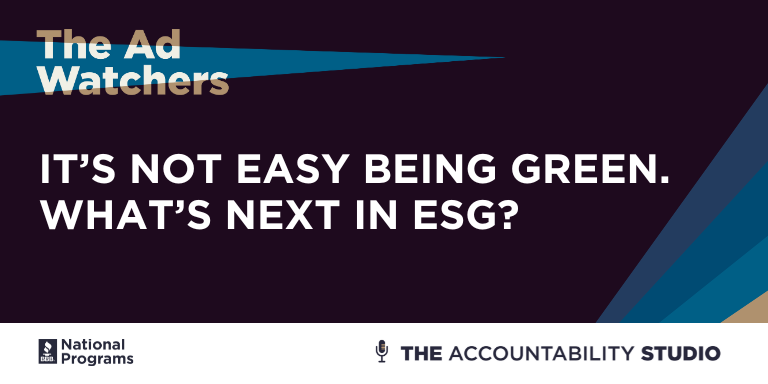
In this episode of Ad Watchers, National Advertising Division (NAD) Assistant Director Annie Ugurlayan and attorney Dan Range are joined by a familiar personality to discuss claim substantiation for green claims. Former Ad Watchers host—and current Legal Director at The Clorox Company—La Toya Sutton, returns to share insight on her approach to ensuring responsible advertising of brands’ environmental impact.
01:45 – Just as our last episode orbited the recently released Health Products Compliance Guidance, Dan and Annie focus this conversation on the Federal Trade Commission’s (FTC’s) document Guides for the Use of Environmental Marketing Claims (“Green Guides”). The guidance covers three areas: universal principles for environmental marketing claims, methods for substantiating and interpreting specific claims, and strategies for qualifying claims to prevent consumer deception.
Annie explains that this guide is under review for the fourth time since its release in 1992. The past revisions were made in 1996, 1998, and 2012. The FTC recently sought feedback on the continuing need for the guides, their economic implications, their impact on the accuracy of environmental claims, and their compatibility with other regulations. They also requested comments regarding the consumer perception of environmental claims, including those not presently covered in the guidelines. Specific terms they expected to hear about were “recyclable,” “organic,” and “sustainable.” The period for public comments closed on April 24, 2023.
06:30 – As an example of the care advertisers must take when making environmental claims, Dan references a case involving Dyper, the diaper brand. A challenge was brought against Dyper’s claim that its product was “biodegradable.” This claim was published on a colored chart on the website that highlighted four biodegradable components of a Dyper diaper.
Though NAD determined that the challenged chart clearly and conspicuously indicated that only certain components of the diaper were biodegradable, they also recognized that the claim could still be misleading as to the ability of those components to degrade in practice. The elements would only degrade under specific conditions which are not always possible to or practical for consumers. So NAD recommended that Dyper’s claim be further qualified to clarify the circumstances in which the components would actually break down.
16:55 – Dan asks La Toya how she works with other departments at Clorox to explain environmental claim substantiation standards and ensure claims are true and not misleading. She highlights the importance of full transparency and communication between departments to avoid deceptive marketing and “greenwashing.” Excited about a new innovation or unaware of the specific connotations of certain words like “green,” “sustainable,” or “eco-friendly,” marketers may accidentally integrate phrases into their claims that aren’t entirely accurate. Keeping the legal team involved in the development process allows them to help identify inaccuracies or areas of improvement early on and reduces the potential for a greenwashed claim.
A 2022 report found that 58% of executives globally and 72% of North American executives admitted their own company has engaged in some form of greenwashing. When companies fail to use effective communication between departments or hold themselves to promises, they are more likely to make false or misleading claims. This causes consumers to lose faith and ultimately hinders meaningful progress. It is crucial for businesses to be transparent regarding their sustainability initiatives and take measures to ensure their commitments are authentic.
Dan closes the episode by pointing listeners to a previous episode for more information on green claims. In Season 2, La Toya and another Ad Watchers alum Eric Unis ask, “How Can You Avoid the Grey Areas of Green Claims?”
Visit to Learn More: NAD FAQs
Contact Information: programs@bbbnp.org
Listen to the full episode here.

